Visiting Rocky Mountain National Park in December
Learn all about what to expect visiting Rocky Mountain National Park in December (Written by Erin McCarthy)
Thinking about where to plan your holiday vacation? Rocky Mountain National Park in December is a winter wonderland that is perfect for the holiday season—explore hundreds of trails with cross-country skis and then warm up by a cozy fire. Estes Park, on the east side of Rocky Mountain National Park, has a range of holiday activities for every interest. While December is a truly spectacular time of year to visit if you love winter, there are some drawbacks to keep in mind. Read on for our complete guide to visiting Rocky Mountain National Park in December for all the details.
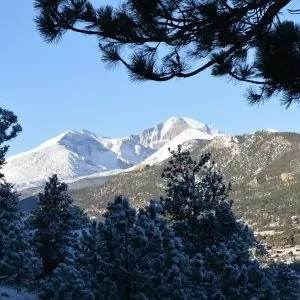 benefits of visiting in december
benefits of visiting in december
The biggest benefit of visiting Rocky Mountain National Park in December is that there are significantly fewer visitors than in previous months. December has slightly over 100,000 visitors as compared to even October with three times that number. The many hiking trails in the Park can be explored by snowshoes or cross-country skis and are much less crowded. Depending on which entrance you choose, there are rentals for both activities available in Estes Park (east entrance) and Grand Lake (west entrance).
If you’re new to high elevations and alpine and sub-alpine exploration, consider booking a guided snowshoe tour. Wildland Trekking offers luxurious lodge-based tours as well as winter day hikes to Emerald Lake and Black Lake. No prior experience is needed. You’ll trek across frozen mountain lakes and through alpine meadows. Keep your eyes peeled as you may spot an elk or a bighorn sheep! When you return to the lodge after a day of winter exploration, cozy up with a home-cooked meal and enjoy a good night’s sleep in a luxurious bed.
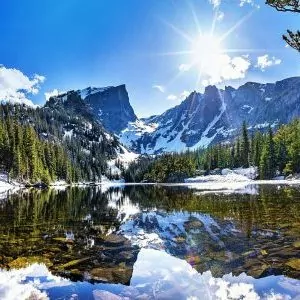 drawbacks of visiting in december
drawbacks of visiting in december
In December, some trail access will be limited as certain roads close in the winter months. Trail Ridge Road is only open for seven miles (up to Many Parks Curve) and Old Fall River Road is completely closed to vehicular traffic beginning in October. However, you can snowshoe or cross-country ski on Old Fall River Road in December.
All of the open roads in the Park will present winter driving conditions— slippery ice and blowing snow. Make sure you have a reliable vehicle and always pack extra food, water, flares, and blankets in case of an emergency. It is imperative to check the current road conditions before you head out.
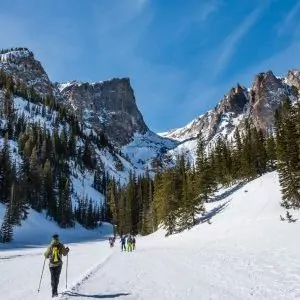 things to do in december
things to do in december
A December visit to Rocky Mountain National Park is the chance to experience the celebration of winter. No matter your fitness level or cold tolerance, there are plenty of options for various activities. Below are our recommendations for things to do in December:
Holiday events in Estes Park: the town of Estes Park, on the east side of Rocky Mountain National Park, has events throughout December to ring in the holiday season. Breakfast with Santa, holiday light tours, and Festive Friday shopping are just some of the possibilities. Check out the full list of events here.
Snowshoeing: a visit in December will almost guarantee that you need snowshoes for hiking in Rocky Mountain National Park. Estes Park Mountain Shop has rentals and many of the lodges in town provide free snowshoes for their guests. Hiking in the winter is a chance to experience the Rocky Mountains at their most majestic—snow-covered peaks, frozen alpine lakes, and evergreen branches bowing to the snowpack.
Cross-country skiing: Since Trail Ridge Road is closed up to Many Parks Curve, it is a perfect place to ski and see snow-capped peaks and views from some of the highest points in the Park. Keep in mind you’ll be at an alpine tundra elevation, so be prepared for changing weather and potentially high winds. A second option is Sprague Lake, a 3.3-mile loop that is perfect for the beginner skier since it is mostly flat. Right outside the Park is the Grand Lake Nordic Center which has twenty-one miles of groomed cross-country ski trails with stunning views of the Continental Divide.
Ice climbing: Rocky Mountain National Park is a world-class destination for ice climbing—a challenging activity that requires patience and the right conditions. If you’re new to the sport you can book a trip with a guide in Estes Park, the Colorado Mountain School, or Kent Mountain Adventure Center.
Ice fishing: Within the Park borders in the winter months, ice fishing is permitted with a valid Colorado fishing license. Brown, brook, rainbow, and cutthroat trout abound. Keep in mind there is no machinery allowed—only hand augers are permitted to cut the ice.
Soak in Hot Springs: After a long winter’s day, there is nothing better than defrosting in a natural hot spring. Though there are no hot springs within the national park boundary, 20 miles southwest of the Grand Lake entrance sits Hot Sulphur Springs. Soaking in 200,000 gallons of naturally steamy spring water will ease your every ache and pain.
Sightseeing on a Bus Tour: If you’d rather stay warm and dry to see the sights, there is an option to book a winter bus tour with Rocky Mountain Conservancy. Enjoy a cup of hot cocoa while you peak at grazing elk and snow-capped peaks.
Winter wildlife watching: The quiet winter months are a spectacular time to spot wildlife. On the east side of the Park, elk descend down to the montane meadows and even into Estes Park. In the west, moose can be found in Kawuneeche Valley. Peep the cliffs in the Northern area at Many Parks Curve of the park to spot bighorn sheep.
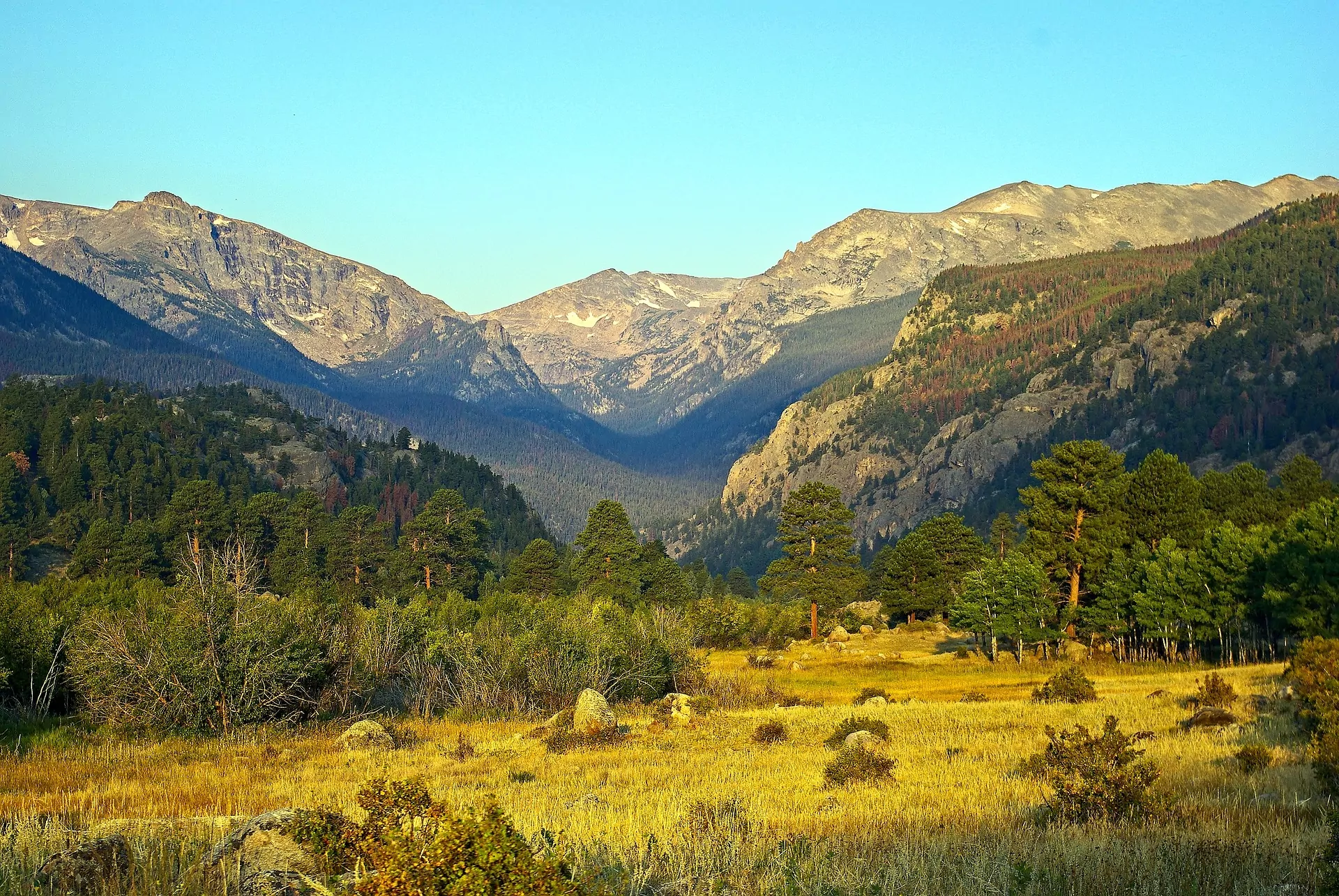
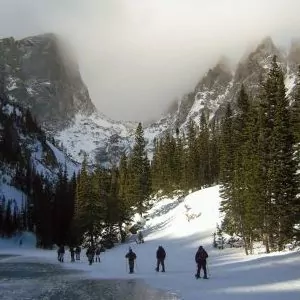 hiking in december
hiking in december
The options for hiking in December are largely limited to lower elevations unless you’re an experienced mountaineer. If you feel confident hiking in winter conditions, check out our list of recommended day hikes in Rocky Mountain National Park which includes some challenging winter routes. Be advised that avalanche conditions could exist, so be sure to check out the most current avalanche conditions. If you are a less experienced winter hiker, you’ll want to stick to the large meadow valleys and gentle slopes of the montane ecosystem. Below are five recommendations for lower-elevation winter hiking in Rocky Mountain National Park:
1. Bear Lake
- Mileage: 0.8 miles round trip
- Elevation Gain: 45 feet
- Trailhead: Bear Lake
On this short but sweet hike, normally one of the most popular hikes in the summer, you’ll travel through the subalpine forest filled with spruce, fir, lodgepole pine, and aspen. It is recommended that you travel in a counterclockwise direction along Bear Lake. Near the beginning of the trail, near the eastern shore of Bear Lake, is a fantastic view of Hallett Peak. On the north side, of the lake you’ll see Half Mountain and Longs Peak. If you’re new to snowshoeing, this is a perfect short hike to get you started.
2. Cub Lake
- Mileage: 4.8 miles round trip
- Elevation gain: 570 feet
- Trailhead: Moraine Park
As you begin your hike, you’ll cross the Big Thompson River and travel along the western edge of Moraine Park. Turn right at the trail junction a half mile in marked Cub Lake Trail. Continue west alongside Cub Creek and Beaver Ponds. About two miles in, the trail begins to climb through aspen groves and rocky terrain and eventually to the pine-covered shores of Cub Lake. Make sure to look west for a view of the snow-capped 12,922 ft Stones Peak.
3. Dream Lake
- Mileage: 2.2 miles round trip
- Elevation gain: 450 feet
- Trailhead: Bear Lake
From the Bear Lake trailhead, you’ll branch off to the left to join the Dream Lake trail. The trail begins to climb up to Nymph Lake with views of Longs Peak. Continue along the trail or across Nymph Lake if it’s frozen. Stunning views of Hallett Peak and Flattop Mountain can be seen from the east shore of Dream Lake. If you’re seeking more miles, at this juncture you have the option to continue to Emerald Lake (0.6 miles) or to Lake Haiyaya (0.9 miles).
4. Gem Lake
- Mileage: 3. 2 miles round trip
- Elevation gain: 1,000 feet
- Trailhead: Lumpy Ridge
The Gem Lake trail is a steep climb up to a picturesque alpine lake at the top of a ridge. You’ll travel along switchbacks amongst ponderosa, aspen, and fir trees. About 1.5 miles along the trail is “Paul Bunyan’s boot”— a rock formation in the shape of a giant hiking boot with a hole in the sole. At this point, it’s a good idea to take a quick water and snack break, as the trail soon becomes very steep. The stone steps in the trail can be 15-20 inches high. This climb is certainly worth it to reach the stunning views of the quiet, frozen Gem Lake.
5. Deer Mountain
- Mileage: 6.2 miles round trip
- Elevation gain: 1,210 feet
- Trailhead: Deer Ridge Junction
This is one of the most popular trails in Rocky Mountain National Park with good reason. In the winter, it will be much less crowded and all the more breathtaking. You’ll hit a trail junction about a tenth of a mile in. Continue straight along the ponderosa pines and open meadows for the first mile, keeping an eye out for deer and elk. You’ll have views of Little Horseshoe Park and the Mummy Range on your left as you travel east. On the right, you’ll have views of Moraine Park, Longs Peak, Hallett Peak, and the Continental Divide. The next mile climbs up the western slopes of Deer Mountain along switchbacks. The trail then flattens out and drops a bit before reaching the summit trail junction. After the third mile, you’ll arrive at the summit trail junction. Turn right where a steep climb to the summit and stunning 360° views await you.
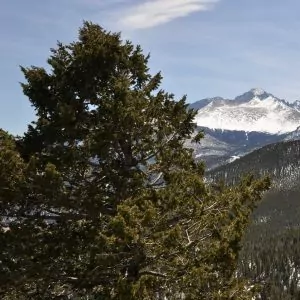 weather in december
weather in december
December is the start of true winter in the Park, so you can expect cold temperatures and a decent amount of snow. The east side of Rocky Mountain National Park at Estes Park (7,500 feet) has less snow but still has cold temperatures even at lower elevations. The west side of the park at Grand Lake (8,300 feet) has more snow, but less wind. In Estes Park in December, you can expect a high of 35ºF (1ºC) and a low of 18ºF (-7 ºC), and an average snowfall of 5.5 inches. At Grand Lake in December, there is a high of 30ºF (-1ºC) and 0ºF (-17 ºC) and an average snowfall of 16.8 inches.
Rocky Mountain National Park has three distinct ecosystems in addition to the riparian that runs throughout each. Above 11,000 feet sits the alpine tundra, with strong winds, cold temperatures, and extreme weather patterns that can change quickly. Winter at this elevation lasts from October through May and constitutes one-third of the Park. The subalpine areas (9,000- 11,000ft) are also extreme in winter. The montane areas (5,600 – 9,500 ft) are usually more moderate and warmer and drier in the winter.
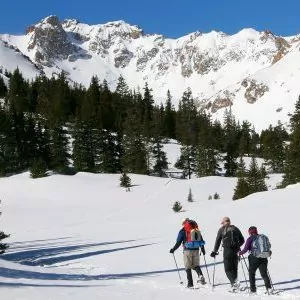 JOIN A GUIDED winter HIKING ADVENTURE
JOIN A GUIDED winter HIKING ADVENTURE
Our Rocky Mountain National Park Snowshoe tours include:
Lodge-based Rocky Mountain Snowshoe Tour – this is a 4-day adventure with local lodging in Estes Park, transportation into the Park each day, snowshoe, backpacks and ski poles, all meals and snacks (including hot drinks on the trail), and a professional Colorado mountain guide.
Emerald Lake Half-Day Snowshoe Tour – this tour is 4-5 hours and includes snowshoes, ski poles, snacks, hot drinks, local transportation, and a professional Colorado mountain guide.
Black Lake Full Day Snowshoe Tour – this 7-8 hour tour includes snowshoes, lunch, snacks, hot drinks, local transportation, and a professional Colorado mountain guide.
ROCKY MOUNTAIN ADVENTURE TOURS
- GUIDED BACKPACKING ADVENTURES: these are for people interested in an authentic Rocky Mountain adventure away from the roads and crowds.
- PORTERED & LLAMA TRIPS: on these innovative trips, guests hike with light day packs and camp near stunning backcountry locations.
- INN-BASED PACKAGES: these tours are all-inclusive packages with lodging, amazing daily hikes, expert guides, meals, transportation, and more!
- CAMPING-BASED HIKING PACKAGES: camping-based hiking packages provide all-around hiking experiences of Rocky Mountain on wonderful outdoor vacations.
- DAY HIKE TOURS: maximize your day in Rocky Mountain on a fully guided, award-winning hiking tour on one of the Park’s best trails.
About the Author
 Erin McCarthy is a freelance writer and former Colgate University Outdoor Education Leader. When Erin isn’t writing, she is exploring the mountains and rivers of the Greater Yellowstone Ecosystem. You can view her complete portfolio at www.erinannmccarthy.com.
Erin McCarthy is a freelance writer and former Colgate University Outdoor Education Leader. When Erin isn’t writing, she is exploring the mountains and rivers of the Greater Yellowstone Ecosystem. You can view her complete portfolio at www.erinannmccarthy.com.






